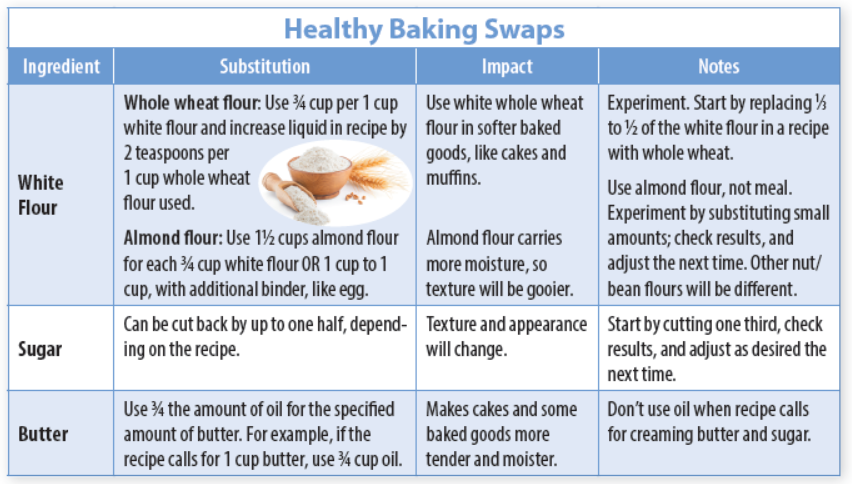The winter holidays are the season for sweets. Though this year may be different, many of us will still find a way to continue the tradition of baking, exchanging, and enjoying holiday treats. And while it is important to embrace these pleasures of the season, we all know the aftermath of an overindulgence can last much longer. Not to worry! Navigating the minefield of desserts doesn’t have to mean passing up every tempting option—or beating ourselves up when we don’t. All it takes is a few smart strategies.
Know Your Enemy: Added sugar is essential in the icing on a cinnamon roll; pound cake is defined by that pound of butter; pie crusts are not flaky without butter or shortening; and baked goods like cookies, brownies, quick breads, and cakes rely on refined flour and added sugars for texture and flavor. Refined white flour, added sugars (including “natural” sugars like honey, agave, and maple syrup), and saturated fats are the foundation of our favorite treats, but excess intake is also a recipe for increased risk of diabetes, heart disease, and obesity. Rather than trying to deny yourself the joys of the season altogether, it’s ok to improve favorite recipes with healthier ingredients, or even enjoy them as they are in moderation.
“Improve” Your Desserts: Healthy ingredient swaps won’t necessarily make desserts good for you, but they will improve them from a health perspective without sacrificing flavor and enjoyment. Making cakes and other baked goods with oil instead of some or all of the butter boosts the healthy unsaturated fat and shifts the balance away from the saturated fat, according to Alice H. Lichtenstein, DSc, professor at the Friedman School and executive editor of Tufts Health & Nutrition Letter. It also has the added benefit of producing a moister, more tender cake. “Substituting at least half the white flour with white whole wheat flour (or regular whole wheat flour) or replacing some of the white flour with almond flour is another way to improve the dietary quality of desserts,” says Lichtenstein. “Just be aware that almond and other non-wheat flours will impact the texture of your baked goods. Adding chopped walnuts or sunflower seeds will add interesting texture and increase fiber, which may lead to a more moderate portion size,” Lichtenstein adds.
Try these tips to enjoy holiday treats in a healthier way (and with less guilt):
- Improve desserts: Cutting back on sugar and swapping in some whole wheat flour can somewhat improve the healthfulness of baked goods.
- Go mini: Make and choose bite-sized portions so it’s easier to sample just a taste.
- Spread the wealth: If you bake or receive a lot of goodies, set up a (contactless) delivery to neighbors and freeze some for future gatherings.
- Treat yourself: Be selective and prioritize those treats you really want—and truly enjoy them.
Sugar contributes to tenderness, texture, browning, and aeration, so cutting it will impact more than just sweetness. Still, leaving some of the called-for sugar out of most recipes will change them, but not ruin them. If you want to cut sugar (or introduce sugar substitutes) in a recipe, you should plan to experiment. Conventional wisdom recommends not cutting more than a third of the sugar, but some recipes can handle more. (If sugar plays an integral role—such as in merengues or candy, or even a simple yellow cake—cutting is not really an option.
Plan Ahead: A little forethought can make all the difference when it comes to enjoying the season’s favorite treats.
Shop Smart: Packaged brownie and cake mixes, refrigerated cookie dough, frozen pies, and bakery items are certainly convenient and tasty, but these items are likely high in refined flours, sugars, saturated fats, and artificial ingredients. Some are better than others, so compare the Nutrition Facts labels and ingredient lists of different options before choosing. If your holiday schedule calls for a last-minute purchase, choose mini or bite-sized desserts, which deliver just a taste of decadence.
Size it Right: Prepare or package homemade and store-bought goodies into modestly sized portions. Mini muffin tins, tiny cookie cutters, mini cake and loaf pans, the smallest cookie scoop, or just a knife make it easy to serve bite-sized desserts. Offering a taste relieves the implied commitment and real temptation to eat that full slice of double chocolate cake. Plus, it stretches recipes—a dozen cupcakes become 24 or more mini muffins, which means more to share, gift, or freeze.
Be selective: You don’t have to try everything. Take an overview of the desserts and focus on just those you absolutely adore or that bring back happy memories. If those must-haves happen to be bite-sized, even better, just don’t fall into the trap of having multiples because they’re “just a taste.” It may help to use a small plate or cocktail napkin to control not only which selections, but how much of them you choose.
Have a plan. Allot yourself a maximum amount you plan to eat each day and stick to it. Store favorite items out of sight to help resist temptation. Consider (contactless) delivery of some of that glut of holiday goodies to family or neighbors, especially those who are not able to connect with others this year, or freeze extras to save them for another occassion.
Savor the flavors: Give yourself permission to enjoy the pleasures of the holiday season. They do come just once a year. So, go ahead and indulge a little bit. Just be sure to savor each (modest) bite and smile as the flavors bring back memories of holidays past and create positive thoughts for holidays to come.

























